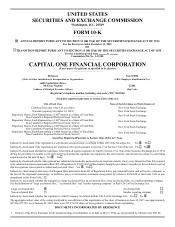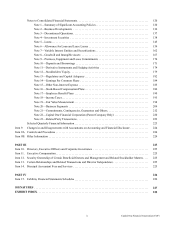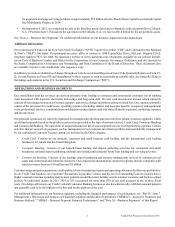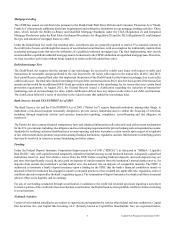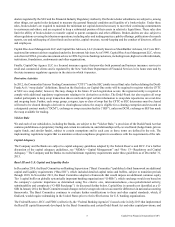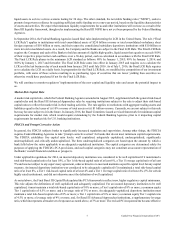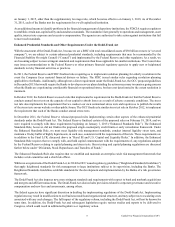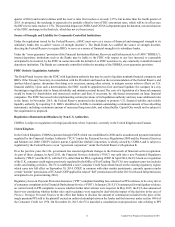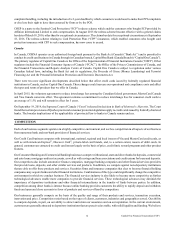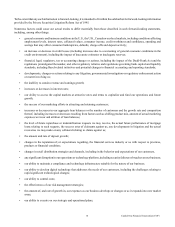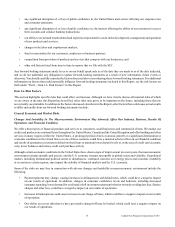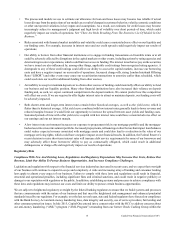Capital One 2015 Annual Report Download - page 25
Download and view the complete annual report
Please find page 25 of the 2015 Capital One annual report below. You can navigate through the pages in the report by either clicking on the pages listed below, or by using the keyword search tool below to find specific information within the annual report.6 Capital One Financial Corporation (COF)
that updated the prompt corrective action (“PCA”) framework to reflect the new regulatory capital minimums (“Final Basel III
Capital Rule”). The Final Basel III Capital Rule increases the minimum capital that we and other institutions are required to hold.
Prior to being revised in the Final Basel III Capital Rule in 2013, the minimum risk-based capital requirements adopted by the
Federal Banking Agencies followed Basel I. In December 2007 the “Advanced Approaches” version of Basel II was adopted. The
Final Basel III Capital Rule modified both Basel I and the Basel II Advanced Approaches (as modified, referred to respectively
as the “Basel III Standardized Approach” and the “Basel III Advanced Approaches”).
The Basel III Advanced Approaches is mandatory for those institutions with total consolidated assets of $250 billion or more or
total consolidated on-balance-sheet foreign exposure of $10 billion or more. We became subject to these rules at the end of 2012.
Prior to full implementation of the Basel III Advanced Approaches framework, organizations must complete a qualification period,
known as the parallel run, during which they must meet the requirements of the rule to the satisfaction of their primary U.S. banking
regulator. According to the rule, parallel run must last at least four quarters, though in practice it has taken U.S. banks considerably
longer to complete parallel run. We entered parallel run on January 1, 2015. Compliance with the Basel III Advanced Approaches
framework requires a material investment of resources in building processes and systems.
The so-called Collins Amendment to the Dodd-Frank Act, as implemented in the Final Basel III Capital Rule, establishes a capital
floor so that organizations subject to the Basel III Advanced Approaches may not hold less capital than would be required using
the Basel III Standardized Approach capital calculations. Based on current rules and our business mix, we estimate that our Basel
III Advanced Approaches ratios will be lower than our Standardized Approach ratios.
The Final Basel III Capital Rule revised the definition of regulatory capital, established a new common equity Tier 1 capital
requirement, set higher minimum capital ratio requirements, introduced a new capital conservation buffer of 2.5%, introduced a
new countercyclical capital buffer (currently set at 0.0%) and updated the PCA framework. Compliance with certain aspects of
the Final Basel III Capital Rule went into effect for Capital One as of January 1, 2014 and other provisions go into effect according
to different start dates and phase-in periods. As of January 1, 2014, the minimum risk-based and leverage capital requirements for
Advanced Approaches banking organizations included a common equity Tier 1 capital ratio of at least 4.0%, a Tier 1 risk-based
capital ratio of at least 5.5%, a total risk-based capital ratio of at least 8.0% and a Tier 1 leverage capital ratio of at least 4.0%. On
January 1, 2015, the minimum risk-based capital ratio requirements increased to 4.5% for the common equity Tier 1 capital ratio
and to 6.0% for the Tier 1 risk-based capital ratio, and the minimum requirements for the total risk-based capital ratio and Tier 1
leverage capital ratio remained the same. Both the capital conservation buffer and the countercyclical capital buffer will be phased-
in over a transition period of four years commencing on January 1, 2016. On January 1, 2014, we started to use the Basel III
Standardized Approach, including transition provisions, for calculating our capital ratios. On January 1, 2015, we began to use
the Basel III Standardized Approach for calculating our risk-weighted assets in our regulatory capital ratios, which were previously
calculated under Basel I.
The Final Basel III Capital Rules also introduced a new supplementary leverage ratio (“SLR”) for all Advanced Approaches
banking organizations with a minimum requirement of 3.0%. In September 2014, the Federal Banking Agencies issued a final rule
that revised the calculation of total leverage exposures. The SLR compares Tier 1 capital to total leverage exposures and includes
all on-balance sheet assets and many off-balance sheet assets, including derivatives and unused commitments. The new SLR
becomes effective on January 1, 2018. However, as an Advanced Approaches banking organization, we were required to calculate
and publicly disclose our SLR beginning in the first quarter of 2015.
For further information see “Part II—Item 7. MD&A—Capital Management.”
On July 20, 2015, the Federal Reserve approved a final rule establishing a G-SIB Surcharge for U.S.-based G-SIBs. The final rule
establishes a methodology for determining which U.S. BHCs are considered G-SIBs and thus subject to a G-SIB Surcharge. A
U.S. BHC whose score using the prescribed methodology equals or exceeds 130 is considered a G-SIB under the final rule. U.S.
BHCs with total consolidated assets of $250 billion or more or total consolidated on-balance-sheet foreign exposure of $10 billion
or more are required to determine annually, before December 31, beginning in 2015, whether or not they are considered G-SIBs
for purposes of the G-SIB Surcharge. In connection with approving the final rule, the Federal Reserve identified eight U.S. BHCs
that would be identified as G-SIBs based on the most recent available data. Capital One was not identified as a G-SIB based on
the most recent available data.
The Basel Committee also published a liquidity framework in December 2010, which was subsequently amended. The liquidity
framework includes two standards for liquidity risk supervision, each subject to observation periods and transitional arrangements.
One standard, the liquidity coverage ratio (“LCR”), seeks to promote short-term resilience by requiring sufficient high-quality



